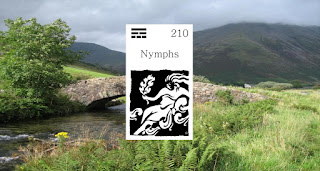Bards (Storytelling)
Around a fire, the old stories are told again. In the telling of stories the past more consciously bears upon the present. Set against the long story of life, the familiar and unusual mingle to form the contours and patterns of our lives.
Invoking the Qualities of Remembrance and Identity.
IF YOU ARE DRAWN TO THIS ORACLE, knowing and interpreting the long story of your life - or the long story of your family, community, or people - is important to you. Sacred texts, great literature, or science fiction that probes the boundaries of the future may unexpectedly seem more relevant to you.
One local storyteller narrates the history of the people, another relays romantic tales playing fact against fiction, and yet another recites poetry as if words were waves upon the sea. Another storyteller, perhaps an itinerant bard, sings heroic ballads, runes and incantations, songs of romance, or lullabies for children. Genealogies and epics retain the long memory of generations and seldom change. Other stories fashion plots, both old and new, breathing new life and interpretation into changing circumstance.
The most well-known bard of the Celtic tradition is Taliesin Pen Beirdd, the bard of the isle of Britain, who lived in Wales during the second half of the sixth century. A large corpus of songs, poems, and lore are attributed to him. Although much of this work actually comes from medieval times, it is identified with Taliesin to enhance the prestige of the bardic orders in Britain. Nonetheless, the poems of Taliesin stemming from the sixth century, and probably predating his time, relay much of what we know of the ancient bards whose words bestowed blessings on friends and, on the darker side, the curse of satire on foes. Taliesin speaks of his origins:
"I was instructor to the whole universe.
I shall be until the judgement on the face of the earth. . . .
There is not a marvel in the world Which I cannot reveal."
Notwithstanding Taliesin's immodesty, the bards conveyed through the centuries the mysteries of lore and tradition. Stretching back before recorded time, the most important role of itinerant bards and village storytellers was to preserve a vast body of oral lore, including history and genealogies, poems and songs, epic tales, riddles, incantations, knowledge of disputes and settlements, and law.
Travelling from parish to parish in the late nineteenth century, Alexander Carmichael visited many such storytellers and recorded their tales and songs. The storytellers Carmichael sought out were already old; they had learned their poems and stories as children from old storytellers who had learned them when they were children. In this manner, the tales and poems Carmichael collected travel back in memory to the first half of the seventeenth century. Carmichael tells of an itinerant storyteller of early eighteenth-century Scotland, one Catherine Macaulay, who "wandered from house to house, and from townland to townland ... and remained in each place longer or shorter according to the population and the season.... [reciting] night after night, and week after week ... poems and stories ... long and weird." One storyteller of the Outer Hebrides was Janet Campbell, a nurse, who "had many beautiful songs and lullabies of the nursery... [H]er stories had a charm for children ... listening to what the bear said to the bee, the fox to the lamb, the harrier to the hen, the serpent to the pipet, the whale to the herring, and the brown otter of the stream to the silvery grilse of the current."
Some of your own life stories will not change, or only slightly. Others, reflected in the mirror of current circumstance, will change dramatically. In the act of telling stories, the past more consciously bears upon the present. Former times are revisited and integrated, sometimes in startling ways. Familiar and seemingly stray events are probed for meaning. In your stories, the familiar and unusual are bound to mingle, forming the rich contours and patterns of your life.
The art of storytelling is active, not passive. Though a story is unchanged from an earlier telling, it nonetheless brings reminiscence, meaning, and identity. What is more, a changing story may contain the promptings and guidance of spirit. Watch your own tellings for changes - they may indicate a shifting of awareness as well as prospects for the future.


















